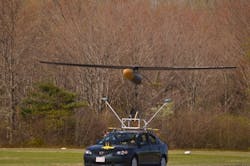Gas-Powered Drone Remains Aloft for Five Days
A team of MIT engineers has developed and tested a drone that can hover and remain on station or circle a target to provide wide-ranging communications support for up to five days, longer than any other gas-powered drone. It resembles a glider and has thin wings that span 24 ft.. The aircraft carries up to 20 lb of equipment while flying at up to 15,000 ft. It weighs just under 150 lb and is powered by a 5-hp gas engine.
In the event of a natural disaster that disrupts phone and internet systems over a wide area, the drone could fly over affected regions, providing temporary telecommunications coverage to those in need as well as emergency forces.
Current versions of unpiloted aerial vehicles are often expensive to operate and can only remain in the air for a day or two, as is the case with most autonomous surveillance aircraft operated by the military. Providing adequate and persistent coverage would require a relay of several aircraft, landing and refueling around the clock, with operational costs of thousands of dollars per hour for each UAV.
The drone began as a student project that was suggested by the U.S. Air Force. It wanted a drone, powered by the sun, that could potentially remain in flight indefinitely. Others, including Google, have experimented with this concept, designing solar-powered, high-altitude aircraft that could provide continuous internet access to rural and remote parts of the world.
But when the MIT student team looked into the idea and analyzed the problem from an array of engineering perspectives, they decided solar power—at least for long-duration emergency response—was not the way to go.
“A solar vehicle might work fine in the summer season, but in winter, particularly if you’re far from the equator, nights are longer, and there’s not as much sunlight during the day. So you have to carry more batteries, which adds weight and makes the plane bigger,” says R. Joh Hansman, a professor of aeronautics and astronautics at MIT and a team leader. “For disaster relief, this could only respond to disasters that occur in summer, at low latitude. That just doesn’t work.”
The researchers came to their conclusions after modeling the problem using GPkit, a software tool developed by Warren Hoburg, another MIT instructor. It lets engineers determine the best design decisions or dimensions for a vehicle, given certain constraints or mission requirements.
This method is not unique among aircraft design tools, but unlike other tools that only take into account several major factors GPkit let the team consider around 200 constraints and physical models simultaneously, and to fit them together into an optimal aircraft design.
“It gives you all the information you need to draw up the airplane,” says Hansman. “It also tells you for every one of those hundreds of parameters, if you changed one of them, how much that would influence the plane’s performance.”
After determining a solar-powered UAV would not be feasible, the team looked at gasoline-powered aircraft. They came up with a design that was predicted to stay in flight for more than five days, at altitudes of 15,000 ft., in up to 94th-percentile winds, at any latitude.
Last fall, the team built a prototype following the dimensions determined by the software tool. To keep the vehicle light, they used carbon fiber for its wings and fuselage, and Kevlar for the tail and nose cone, which houses the payload. They designed the UAV to be easily taken apart and stored in a FedEx box, so it can be shipped to any disaster region and quickly reassembled.
This spring, the students refined the prototype and developed a launch system, fashioning a simple metal frame to fit on a typical car roof rack. The UAV sits atop the frame as a driver accelerates the launch vehicle
“These vehicles could be used not only for disaster relief but also other missions, such as environmental monitoring. You might want to keep watch on wildfires or the outflow of a river,” Hansman says. “I think it’s pretty clear that someone within a few years will manufacture a vehicle that will be a knockoff of this.”


